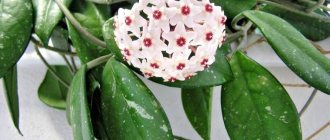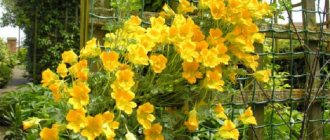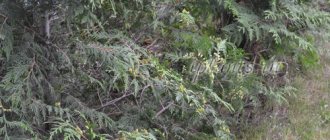If you decide to decorate your plot with ornamental plants and are completely lost in the huge selection, then the easiest way to start is with barberry. This beautiful ornamental shrub is unpretentious, has different colors of leaves and flowers, and comes in different shapes, both dwarf and giant. It lends itself well to molding, so when planning a hedge, this option is the most optimal. Among the many varieties, the most popular and exquisite are: Thunberg barberry, Siberian, Altai, Ottawa and Ordinary. Violet and purple, orange and red, variegated and golden leaves of barberry will turn your site into a small piece of a fantastic island.
When can reproduction be carried out: features
The timing of barberry propagation depends on the chosen method. When cuttings, the procedure is carried out in early spring or, conversely, in the winter. Young branches take root well in greenhouse conditions.
Barberry Thunberg
Dividing the bush is done at the beginning of the season. When the buds begin to swell and the leaves begin to bloom. The leaves will not interfere when dividing the bush. This way you can select the desired piece.
Root shoots appear at the beginning of the season. It takes some of the nutrients from the soil and inhibits the development of the mother bush. It is recommended to remove shoots to make the barberry more luxuriant. But if there is a goal to propagate the plant, then the shoots are left until the end of the season. The procedure begins in the fall.
Propagation of barberry by seeds is a labor-intensive process. The grains are prepared in advance for several months. Layering is done simply. It is advisable at the beginning of the season so that by autumn the new bush can be transplanted to a new location.
It is important to know! The varietal identity is completely transmitted if barberry is propagated by cuttings or shoots.
How and when to propagate barberry: timing and methods
In principle, barberry can be propagated at any time of the year - be it in spring, summer or autumn.
However, certain methods of barberry propagation are suitable for each period:
- So, in the spring (April-May) they plant rooted cuttings and young seedlings, and also propagate by dividing the bush and digging up layering.
- In the summer, cuttings are taken (in July-August), namely, green cuttings are cut and placed for rooting.
It is very undesirable to divide barberry bushes in the summer in the heat (in July), because the plant may not take root due to elevated temperatures.
- In the fall (September-October), the barberry is divided and lignified cuttings are prepared for their further storage in the winter and subsequent planting in the spring, and also the already rooted cuttings are planted in open ground and the rooted cuttings are separated.
Propagation by cuttings
It is easier to cut common barberry in summer than in autumn. Thunberg barberry is considered a special variety. It has beautiful flowers and large fruit ovaries. To reproduce, the bush must be no more than 10 years old. After this age, cuttings have difficulty rooting and growing barberry becomes more difficult. How to properly cut barberry?
How to propagate thuja - cuttings and transplantation
It is easy to grow cuttings of ornamental shrubs. The transplant process occurs according to the following algorithm:
- At the beginning of the season, the bush is inspected, young shoots 15-20 cm long are selected. Lignified branches that have 3-4 internodes are also suitable.
- Preparations are made at any time of the year. Planting is carried out mainly in early summer.
- The lower end of the branches is made oblique. This way it will absorb water faster and produce roots.
- If there are leaves, cut them in half.
- On the first day, leave the cuttings in water with the addition of a root formation stimulator.
- Next, the cuttings are transferred to the ground or left in water until the first roots appear.
- If the branches are planted in the ground, they are covered on top with a glass jar or plastic bottle. A greenhouse effect is created inside.
- You can immediately plant the cuttings in a greenhouse.
Additional Information! Without a root formation stimulator, barberry produces roots very slowly.
Cuttings of barberry in summer ensure better survival rate. Winter branches take root worse.
How does barberry reproduce in natural conditions?
Barberry is a large shrub that can grow up to 2 m in height. It is highly decorative all year round. It blooms with yellow flowers collected in clusters. The fruits are ruby in color and are often decorated with bare shoots even in winter. The foliage turns bright red in autumn.
Varieties have been developed in which the leaves have patterns, borders, or are colored in unusual shades.
If you give barberry freedom for several years, then, like rose hips, it will take over the entire adjacent territory with shoots. In addition, this bush reproduces well by self-sowing. But if your goal is to obtain cultivated seedlings that retain varietal qualities, then it is better to use reliable and proven agricultural propagation methods.
Thickets of barberry look very beautiful, but it is simply impossible to care for such a continuous mass of shoots with sharp thorns
Dividing the bush
Barberry Cobalt - variety description and care
How to properly propagate barberry by dividing the bush? The issue is easily resolved. New bushes quickly take root when:
- They dig up the mother bush.
- They move him to the shade.
- Using scissors, you need to divide the plant into 2 equal halves. At least 3 shoots should come from each daughter barberry.
- 2 holes are dug in the garden. The soil is mixed with fertilizers and well moistened.
- Bushes are planted in a new habitat.
- After 2 weeks, the plants will fully recover.
Barberry in autumn
This method is better for growing young bushes. Digging up a large mature shrub is difficult. During work, you can scratch yourself, break healthy branches and harm the plant.
Medicinal properties of barberry root
An infusion of barberry root has antispasmodic, choleretic, diuretic, enveloping and astringent properties. Improves blood clotting and helps dissolve salts in the body. However, taking the infusion is not recommended during pregnancy and in the acute phase of the disease. The beneficial properties and contraindications for barberry root are explained by a combination of natural components:
- organic acids;
- alkaloids;
- tannins;
- vitamins E and C.
An infusion of barberry root is used:
- For gastrointestinal diseases.
- If kidney function is impaired.
- For inflammation of the bladder.
- For bronchopulmonary diseases.
- For blood clotting disorders.
To prepare the infusion, use 1 tsp. crushed barberry root, pour 0.5 liters of boiling water and leave for 20 minutes. Strain through a sieve and drink 2 tbsp. l. 3−4 times a day.
Air layering
Barberry Ottawa Superba - description and care
How does barberry propagate by layering and what is it? Everything is actually very simple. An adult shrub growing in the garden. Its branches hang straight to the ground. A couple of them remain in the ground. However, it cannot be cut off from the mother plant. The cuttings are kept in this form until the end of the season.
Sections of the branches will receive nutrition from the soil and from the plant at the same time. Therefore, the survival rate is high. Subsequent procedures and care for layering:
- By the end of summer, they check how well the layering has taken root. The roots should be palpable.
- The tops are cut off from the main bush so that at least 3-4 internodes remain in the new plant.
- It is necessary to plant new barberries in their own holes.
- While the shoots are taking root, they are periodically hilled up. The more land at the base, the better the process goes.
- Plantings are watered every week with 500 ml of water. You can’t overwater them so as not to wash away the soil near the trunk.
- Feeding is carried out at the same level with all barberries.
Barberry fruit
You should know! After rooting the cuttings, cut off the top. They leave the new bush next to the mother one to make it easier for it to adapt to the new type of nutrition.
Rules for breeding different species
It is known that decorative barberry is usually propagated by seeds or vegetatively. To breed any of the types and varieties of barberry, you need to carefully familiarize yourself with all methods of plant propagation. Having studied the characteristics of each species, it will immediately become clear what barberry needs. It is a mistake to believe that choosing the appropriate option is very simple, because each has its own disadvantages. If we talk about the cutting method, it is worth noting that rooting occurs very slowly. When sowing barberry seeds in open ground, a small germination rate is expected, the maximum figure can reach 40%. With all this, the varietal characteristics of the plant are lost. Dividing the bush can negatively affect the rhizome of barberry, and the root shoots are not suitable for all varietal varieties.
It is best to try each method to find one that is suitable for growing a particular barberry variety. So, for an ornamental shrub with red leaves called Thunberg barberry, the method of propagation by cuttings is perfect. The thing is that this type of shrub forms a large number of thin stems, which subsequently serve as suitable planting materials.
Particularly striking is the bright foliage, which is replete with various colors. It can be colored in various shades of yellow, red and green.
Beginner gardeners often make mistakes when growing barberry. The main mistake when propagating by seeds is their small quantity. For sowing, it is necessary to stock up three times more planting material than is needed for other plant varieties. This is due to poor seed germination.
The danger of spoiling a young seedling also arises during the process of digging up root shoots. After dividing the bush, the root system is damaged, and subsequently young plants can suffer for a long time due to the formation of new roots. This method is only suitable for adult plants. Barberry has the ability to reproduce in all existing ways. However, not all of them are suitable for growing certain varieties of shrubs. If you want to get a plant that has all the varietal properties, it is recommended to resort to the method of vegetative propagation.
To learn how to propagate barberry, watch the video.
Seeds
How exactly does barberry propagate from red seeds? Similar to other varieties. At the end of the season, several branches with fruits are left until they are fully ripe. By mid-September, seed pods are formed. Collect them and dry them well. Seed germination lasts for 2 years.
Note! Seed propagation is full of surprises. There is no guarantee that the new plant will inherit all the characteristics of the mother shrub.
Seeds are planted in winter or early summer. Seed germination is higher if you plant fresh seeds for the winter. The process is carried out step by step:
- Prepare in advance a bed 20 cm high from nutritious and dry soil.
- Dig holes. Make a distance of 15-20 cm between them, and 30 cm between the rows.
- A day before planting, soak the grains in water with potassium permanganate.
- The next day, place one seed in each hole.
- Seal the holes with overripe humus.
- Cover for the winter with agrofibre or spandbond.
In spring the first shoots will appear. Not all seeds will germinate quickly; some will appear above the ground only at the beginning of summer. When there are 3-4 leaves on the stem, new bushes are planted in a permanent place. The plants are well watered beforehand to ensure root turgor.
When planting seeds in summer, the grains are first stratified. In March, they are laid out in wet rags, covered with cellophane and sent to the top shelf of the refrigerator. Sprout at home on a wet cloth. Sowing is carried out in early May. By the end of the season, sprouts appear. The germination rate of winter sowing is 20% higher than summer sowing. New bushes can stand for some time, and then die if strong shoots grow next to them.
Decorative variety of barberry
How to propagate a shrub?
When you try to take cuttings from a shrub, you will notice that the shoots do not grow roots well. In order to propagate barberry at home, you will have to take into account some points. Let's list them.
Preparation of material
Growing barberry using the method in question means avoiding its grafting in the future. To do this, you need to take cuttings. Their length should range from 12 to 15 cm. The lower leaves located on the planting material are removed. And the place where roots will subsequently appear is treated with a growth stimulator for the root system.
To do this, the substance is diluted in water, following the instructions, and the cuttings are placed in this solution for a day. This simple method to root a plant is the easiest and most reliable.
Selecting a location
Barberry is a fairly heat-loving plant. Therefore, it should grow only in well-sunny places. In addition, this plant does not like waterlogged soils . In this regard, select a site that will have good drainage and meet all requirements.
Remember that this plant does not accept excessive watering. Lowlands and areas where there is groundwater are contraindicated for its rooting.
Preparing the site and planting hole
If you plan to plant one seedling, it is enough to prepare a hole measuring 45x45 centimeters and 50 centimeters deep. So much space is needed not only for the seedling, but also for the fertilizer that fills the space.
This is interesting: Methods for effectively treating the garden in the fall from diseases and pests
Water is poured into the resulting hole. Next, a layer of drainage in the form of pebbles or pieces of wood is placed on the bottom. After preparing the hole, it is filled with a mixture of peat, soil and humus.
Landing
It is advisable to plant the finished samples in peat and cover with film. When strong roots appear on the seedlings, they must be transplanted into containers with well-moistened and fertilized soil. Rooting in pots allows the greenery to grow stronger.
Remember: to grow a great barberry bush, you need to start with the right planting. Therefore, we prepare the hole according to all the rules. If you plan to plant one seedling, then it is enough to prepare a hole measuring 45x45 centimeters and 50 centimeters deep. Such a large size is needed so that it can easily fit: drainage (placed at the very bottom and consists of broken bricks) and substrate. Next, we place the seedling in the hole, straighten the roots and cover them with the remaining soil.
Then water generously. After this, the soil will settle. We add the missing soil from above, and then be sure to mulch the planting site.
Aftercare
To obtain full-fledged barberry bushes, timely water the seedlings, remove weeds around the root system and fertilize according to the season. Then the young animals will quickly get stronger and overwinter well.
To ensure that the soil retains moisture, it is mulched with a 7-centimeter layer of sawdust or peat. In the second year of life, the plant must be fed with nitrogen-containing substances (you can use mullein) (this is done in the spring).
When flowering begins, it is imperative to support the young planting. This can be done with the help of preparations containing microelements. In the fall, it is advisable to apply potassium fertilizer (10–15 grams of superphosphate per 1 unit).
Subsequently, feed the plant once every 3 years.
Landing at a permanent place
After planting, they wait two years to plant the young ones. To do this, it is necessary to remove the cover from the seedlings around June . Let the plants get used to the environment and get stronger. In mid-September, you can begin transplanting to a permanent place, which must meet all the requirements.
Root shoots
It is customary to remove the root shoots as they interfere with the normal nutrition of the mother barberry. But if you want to propagate the plant, then shoots are perfect. They inherit all the characteristics of the main bush.
Throughout the season, children are cared for in the same way as adult plants. Closer to September, a place for transfer is being prepared. Fertilize the soil with mineral additives. They dig up the baby and plant it in a new place.
Interesting! If barberry produces new babies, it means it is healthy, full of strength, ready for reproduction and active flowering.
The shoots are true bushes. That’s why their survival rate is high. In the first year, the plant is actively fertilized, watered and covered for the winter. This way it will bloom and bear fruit more quickly. Adding a growth stimulator helps the barberry root.
Methods of crop propagation: step-by-step instructions
Barberry is propagated in several ways: by cuttings, dividing the bush and using layering.
To plant seedlings, it is necessary to organize a greenhouse. The process consists of several stages:
- Preparing the base. It consists of compost, on top of which is laid forest litter or a mixture of rotted leaves and soil, laid out 10-15 centimeters high. Next comes a layer of river sand 4 centimeters high.
- The resulting substrate should be thoroughly compacted and watered abundantly.
- The top is covered with film or transparent glass.
The finished greenhouse will be a temporary place for planting cuttings.
Cuttings
Those who want to grow barberry should give preference to cuttings. It is advisable to cut the shoots in the morning, while dew remains on them.
To prepare the cuttings, do the following:
- Prepare a sharp knife.
- Select an annual branch with elastic bark. It is better to choose one with at least 4 internodes.
- Cut off the shoot almost at the root.
- Place the shoot in a container of water.
- Move it to a dark place.
When the material is ready, the shoot begins to be trimmed.
Green cuttings
Green cuttings can be used to propagate the crop. From one-year growth, you need to cut out the middle part of the stem, 8 to 10 centimeters long. All cuts must be made at an angle of 45 degrees.
The finished cuttings can be tied into bunches and placed with the lower cut in a container of water. This will significantly improve the rooting of the resulting seedling. Next, you should plant the cuttings in a greenhouse, and then in the ground.
Woody cuttings
Woody cuttings are also used to propagate the bush. The procedure is carried out at the end of autumn. Biennial shoots should be selected as starting material. They need to be cut 20 centimeters in length.
Then they land in a deep trench. Sprinkling with a layer of mulch (can be replaced with fallen leaves) will help to root the cuttings. When spring comes, the planted cuttings are placed in greenhouses. The further procedure completely repeats the actions with green cuttings.
Dividing the bush
You can grow a beautiful bush by dividing the bush, which is used when it is necessary to quickly obtain young seedlings. The procedure is as follows: the bush is dug out as carefully as possible and cut into pieces. Each cut should be treated with a special paste that stimulates growth. If the root system is sufficiently developed, it is enough to cut the root and plant the resulting seedlings in different holes, after moistening them.
Growing from seeds at home
A healthy bush can be obtained even from a small seed. However, the method of growing barberry with seeds is quite painstaking, and the probability of germination is low. Sowing of seeds is carried out in the autumn, in furrows 3 centimeters deep. Sprouted seeds are cleared of weeds and thinned out. A year later, the seedlings are transplanted to a permanent location of the bush.
Root shoots
Quite often, buds form on the roots of barberry, from which shoots appear. They provide an opportunity to grow new bushes. If growth is detected, do the following:
- Dig up the resulting sprout.
- Cut the connection between the mother bush and the cutting using pruning shears.
- Together with a lump of earth, transplant it to the selected location on the site.
Growing barberry in this way is the most painless for the plant and does not require much effort.
By layering
If there is already a barberry bush on the site, and the owner is happy with it, but you want to add a few more of the same kind to the landscape, you can use layering to propagate the bush. For this, healthy annual branches are selected. Furrows are made around the mother bush and moistened.
Shoots 15 centimeters long are placed in the resulting recesses, secured and covered with earth so that only the tops are visible. During one season, the cuttings are watered, and by autumn, ready-made seedlings with their own root system are obtained.
Common Mistakes
It is not difficult to propagate barberry. However, beginners make mistakes. The most common of them:
- Incorrectly selected cuttings. The length and number of internodes is strictly limited. A branch that is too long will not be able to fully feed, and a short one does not always take root.
- The greenhouse effect has a beneficial effect on survival rate. But it’s worth ventilating the greenhouse once a day. Sprouts need fresh air.
- Too much fertilizer in new soil can burn the roots of the shoot. Add additives strictly according to the instructions.
- It is not recommended to use fresh manure to feed new plants. It contains a large amount of nitrogen, which causes burns.
- Abundant watering is good. But everything should be in moderation. If a lot of moisture accumulates in the ground, the roots and lower part of the cutting will rot.
- When selecting cuttings, they are cut only with a disinfected tool. You can't break off branches. The cut should be oblique, not straight.
- Be sure to use a root former, so new roots will not keep you waiting.
- Cover young bushes for the winter; winter hardiness is not fully evident until the age of three.
Yellow barberry
Thunberg's barberry and its propagation by cuttings are almost no different from other varieties. You need to follow the rules and useful tips and the new shrubs will definitely take root.
Barberry is a wonderful plant that delights gardeners not only with its flowers, but also with its berries. They are used for completely different purposes: they cook compotes, preserves, bake pies and prepare syrups. Shrubs are great for landscape design. They are planted along the fence (it turns out to be a beautiful green hedge).
Nuances of propagation of barberry Thunberg
Barberry Thunberg is the most beautiful ornamental plant with unusual leaf color. Bushes with golden yellow, orange or purple leaves decorate the area from early spring to late autumn. The height of the plant can be from 20 cm to 1.5 m. Barberry bears fruit with edible sour berries.
Propagation of Thunberg barberry is not much different from other varieties; in summer it is easy to propagate the shrub using cuttings. To do this, use the green parts of the shoots, which are planted in a greenhouse. After rooting, the film is removed. The seedlings are fully cared for, and after a year they are planted in a permanent place.
To ensure that all varietal characteristics are transferred from the mother plant to the young bush, barberry is propagated by grafting. It is done in early spring. The cuttings are grafted onto wild barberry, which has good winter hardiness.
Instructions:
- As a scion, take a semi-lignified cutting with a piece of bark.
- A T-shaped cut is made on the rootstock directly around the bud.
- The bark is carefully pushed aside and the scion is inserted there.
- The grafting site is well fixed with a special film and covered with garden varnish.
After a few months, the success of the vaccination can be judged. Young leaves should appear on the barberry cuttings. If this is not the case, then you need to check the vaccination site.
There is another way to propagate Thunberg barberry - eye grafting. A bud is cut from the plant you like along with a piece of bark. Next, it is grafted in the same way as a cutting. The only difference is that the seedlings will develop slowly.
Is it possible to grow barberry from seeds?
The seed method of growing barberry is practiced much less frequently compared to the method of cuttings and dividing the bush. This is due to the low germination rate of the seed and a large amount of preparatory work. And yet, if you correctly collect, prepare and sow the seeds, in 3-4 years a barberry bush will show off on your site.
Planting barberry in spring and autumn in open ground
Publications often contain advice to prepare holes in advance, 2-3 weeks before the planned planting. This is not difficult to do in the fall. But in the spring, when the soil is dense and damp, it is often not possible to dig it up.
That's why I do it this way. I prepare holes and ditches for spring planting in the fall and cover them with film to prevent erosion. But I store the mixture of soil and fertilizers in the shed and fill the holes in the spring, a couple of days before work.
Barberry plants should be separated from each other by a distance of 1.5-2 meters when placed alone. In a hedge, per linear meter there are 2 to 3 bushes, depending on the height of the variety.
How to plant barberry step by step:
- Dig holes . For seedlings with ACS, their size should be 40×40. In the case of ZKS, the recess is dug 2-3 times wider and deeper than the size of the container. The top 20-25 centimeters of soil are placed on a wheelbarrow or cardboard, the rest is placed to the side.
- Prepare a fertilizer mixture. Add a bucket (8-10 liters of volume) of compost or humus, peat and 200 grams (a glass) of ash to the excavated soil. Instead of ash, it is permissible to add mineral fertilizers - for example, potassium sulfate (20-30 g) + superphosphate (50 g), diammofoska (50 g, in autumn) or nitroammofoska (50-100 g, in spring). If the soil is acidic, lime is added to the composition at a rate of 300-400 grams per hole.
- Fill the hole with nutrient substrate . A mound 20-30 centimeters high is poured in the center of the recess. To do this, use the mixture prepared at the previous stage. For a bush in a container, you need to fill the hole to 1/3-½ height.
- Water. If the soil is dry, it is advisable to slightly moisten it with water.
- Plant a seedling. The bush is planted on top of the mound, and the roots are evenly distributed along its sides. The barberry with the ZKS is removed from the container so that the earthen lump remains intact and placed in the center of the hole. The stem is buried so that the root collar (this is the place where the first root grows) is 3-5 centimeters below the soil level.
- Fill the hole with fertilizer mixture . The soil is then moderately compacted and watered on top with 8-10 liters of water. This will remove air pockets around the roots and improve the survival rate of the seedling.
- Wait 1-2 days and add more soil . During this time, the earth will settle - perhaps even the root collar will be exposed. Therefore, backfilling, compacting and re-watering are mandatory.
- Mulch the tree trunk with hay, straw, sawdust, and leaves . In a circle you can build a side 10-15 centimeters high. This way, during irrigation, water will not spill and be wasted.
- Remove the top of the seedling so that 3-5 strong buds remain. This technique is aimed at stimulating branching.
Watch a video about the features of planting barberry with OKS and ZKS:
Where to plant barberry on the site
Barberry Thunberg
The culture is demanding on the level of illumination. To maintain its decorative appearance and a generous harvest, barberry needs at least 7-8 hours of direct sun per day. The best option is to place the bushes in a place where they will receive their dose of light in the morning and evening, but will be in light shade at noon.
Attention! Variegated and edible barberry does not grow in the shade. The first loses its decorative effect, the second produces poor harvests.
Barberry loves moderately fertile soil with neutral acidity (pH 6-7). The shrub does not tolerate close groundwater. They should be located no closer than 1.5-2 meters to the ground surface. It is not recommended to place plantings in those locations where water collects in the spring and stands for a long time.
A good site for shrubs is the southern side of any hill, even of artificial origin.
Advice. Plant barberry away from residential buildings. This culture is a real magnet for the flying brethren, who will constantly drop by to see you.
Thunberg's barberry as a hedge
To understand what you can plant barberry with, you first need to make sure that the plants receive enough light. Tall varieties are placed at a distance of 2-3 meters from other perennials, medium-sized barberries - at 1-1.5 meters. In the case of dwarf species, it is enough to retreat 50-60 centimeters from the neighboring crop.
Barberry is known to be well compatible with the following plants:
- Decorative perennials - hosta, coral heuchera, daylily, astilbe, rose bush, September flower, chrysanthemum.
- Shrubs (for hedges) - lilac, axel, forsythia, jasmine, bladderwort, branched mackerel, deutzia, cinquefoil, spirea.
- Cereals—grass grass, grass molinia, fan grass, meadow grass, fescue, haretail, maned barley, sesleria.
Almost any annual flowers and conifers go well with the culture. You just need to place plants in tiers and choose contrasting colors for a wow effect.
On a note. Cherry, elderberry, common acacia, poplar, and walnut are unfavorable neighbors for barberry. Their roots produce a substance that slows down the growth of the seedling.
Types and varieties
The sheer number of species and varieties of barberry can be confusing, especially since they are all incredibly attractive. When choosing, you should focus on what goal you are pursuing. If you are interested in edible barberry berries, then some types are planted for this, but if you want the plants to decorate your garden or become a picturesque hedge around the site, then there are others for this. But there are species and varieties that can successfully cope with both tasks.
Common barberry (Berberis vulgaris)
The main species of the barberry genus. This is a shrub up to three meters high with gray-brown shoots, on which tripartite spines up to 2 cm long grow. The leaves are elliptical, thin, membranous, with ciliated-serrate edges, the upper side of the leaf plate is dark green, the lower side is dull, gray. green. The racemose inflorescences, up to 6 cm long, consist of brilliant yellow fragrant flowers that bloom for two to three weeks. Numerous bright red fruits reach a length of one and a half centimeters.
- Planting flowers in autumn
This species has a large number of varieties - albo-variegata with white-variegated leaves, aureo-marginata with leaves edged with a golden rim, barberry atropurpurea with red or dark purple leaves. And the berries of the seedless form of barberry asperm are very convenient to process.
There are a number of species similar to common barberry: Provençal barberry (a hybrid of common barberry and Siberian barberry), spinous - a species from the Himalayas, Canadian, Zimbold's barberry, James's barberry and Diels' barberry.
Thunberg's barberry (Berberis thunbergii)
The most beautiful of the deciduous barberries, the champion of the genus among ornamental species. The height of Thunberg barberry is from 50 cm to 1 m, its branches extend horizontally, yellowish or bright red young densely branched shoots are arched, with age they become brown or purple-brown. The spines, 1 cm long, are very thin and elastic. The leaves are elegantly shaped - oblong or obovate, small - no longer than 3 cm, bright green above and bluish below, turning bright red in autumn. Single or clustered flowers, red on the outside of the petals and yellow on the inside, bloom for one to two weeks. Coral-red shiny elliptical fruits up to 1 cm long ripen in early autumn and decorate autumn and even winter bushes for a long time.
The berries of this species contain many alkaloids and therefore taste bitter, but they are an excellent food for birds in winter. Planting Thunberg barberry and further caring for it does not cause any trouble, but the aesthetic pleasure that you will get by growing this species or its varieties on your site is beyond all expectations. Thunberg's barberry has several decorative forms: multi-flowered (pluriflora), dark purple (atropurpurea), silver-marginated (argenteo-marginata) and others. Popular varieties:
- barberry Golden Ring up to three meters high with a rounded crown, ovate leaves up to 4 cm long, dark purple-red in color with a yellow border along the edge. In autumn the leaves take on an intense red hue. The flowers, collected in bunches of 2-5 pieces, up to 1 cm in diameter, are yellow on the inside and red on the outside. Coral-red, shiny berries ripen in October;
- Red Pilar barberry is an attractive columnar-shaped variety up to one and a half meters high and a crown width of up to 45 cm with reddish-purple leaves that turn bright scarlet in autumn;
- barberry Orange Rocket is a columnar-shaped variety, reaching a height of no more than 120 cm and a width of 60 cm. Small smooth ovoid leaves on the current year's shoots are orange with a yellow border, the leaves on last year's shoots are red-purple - the bush looks incredibly attractive against the backdrop of spring and summer greenery. In autumn the leaves turn different shades of red;
- Kornik is a deciduous shrub, one and a half meters tall, with pale green leaves covered with random creamy-white spots of various shapes, as if splashed with paint. In autumn, the green background of the leaves turns scarlet red. The variety looks great next to roses, conifers and other varieties of barberry.
Ottawa barberry (Berberis x ottawensis)
It is an ornamental hybrid between the atropurpurea form of common barberry and Thunberg barberry. This is one of the most spectacular representatives of the genus: from one and a half to two meters in height, it looks like an enlarged copy of the Thunberg barberry, but the color of the leaves is closer to the purple-leaved form of the common barberry - dark pink-violet, almost black in the sun, color. In autumn, the leaves turn crimson and blaze for a long time in a joyless gray garden.
Ottawa barberry is winter-hardy, easy to care for and grows very quickly. Popular varieties:
- Auricoma - up to 2.5 m high, rounded leaves, up to 5 cm long, bright red in spring and summer, orange in autumn, red-yellow flowers up to 1 cm in diameter collected in racemes up to 5 cm long, bright red fruits;
- Superba - up to 4 m high, leaves are round, 3 to 5 cm long, dark red with a bluish bloom, in autumn they turn into various shades of orange and red. Yellow-red flowers are collected in clusters, the berries are red;
- Silver Miles - This variety needs to be viewed from afar as it doesn't look attractive up close: purple leaves with dirty gray smudges. From a distance, the bush acquires a lilac hue due to the fusion of gray and purple flowers.
In addition to the listed types of barberry, Juliana, Bean, Tischler, Morrison, Wilson barberries, greenish, willow, multi-flowered, oriental, Iberian, reticulate, similar, bluish-white, boxwood, notched or unedged, large-thorned, provincial, spring are grown in culture around the world , Ili, coin, Korean, Tibetan, Siberian, transparent, round-serrated, twisted, Amur, Turkmen, whole-edged, oblong, round-fruited, Asian and many others.











